How To: Overclocking Your AMD Processor
Easy Multiplier Overclocking

With a 790GX-based motherboard and Black Edition processors like the ones we are using, it’s fairly simple to get started overclocking using the AMD OverDrive Utility. If your processor is not a Black Edition and the multiplier cannot be raised, you will want to follow the steps laid out in the pages that follow this discussion.
Let’s take a look at the stock settings for our Phenom II X4 940. Our motherboard’s actual reference clock (bus speed) fluctuates between 200.5 MHz and 200.6 MHz on our system resulting in a core speed of roughly 3,007 MHz to 3,008 MHz:
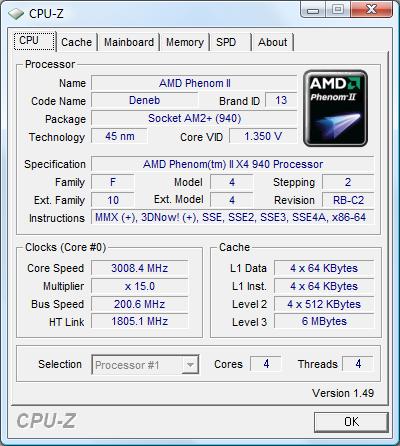
It’s a good idea to run some performance tests at these stock speeds, so there is a base-performance level established for comparison (use some of the metrics suggested earlier, to start). Performance testing can help pinpoint the gains and losses achieved when settings are changed.
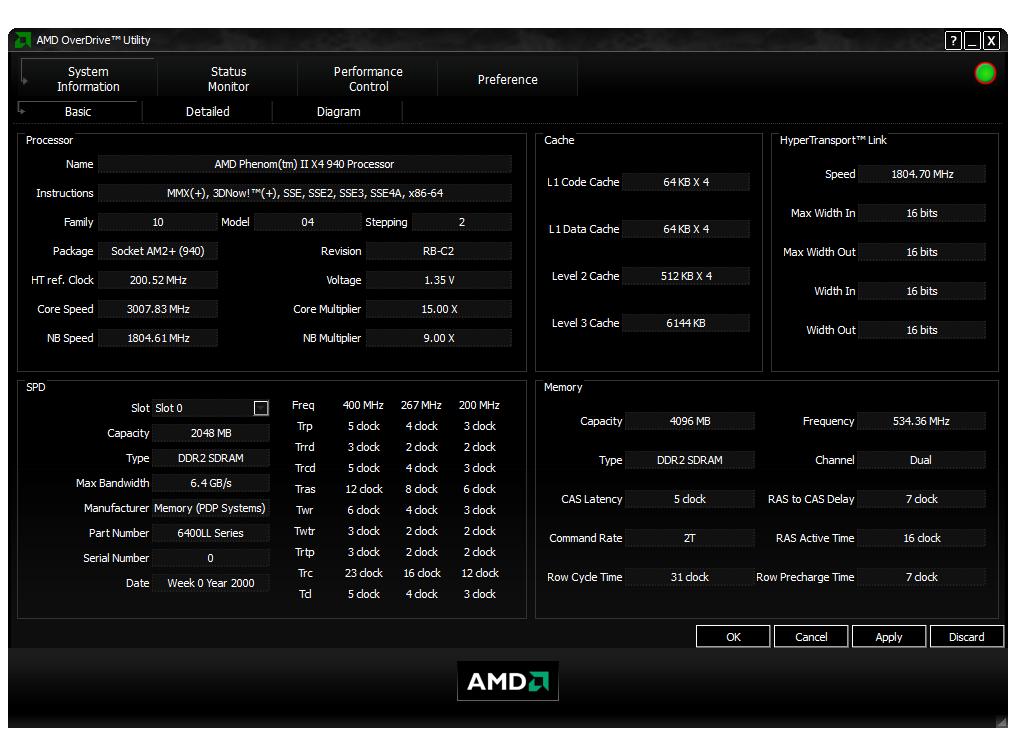
For best results, it’s a good idea to first disable the BIOS options we previously highlighted. If you're unfamiliar with the BIOS, we provide illustrations for BIOS navigation later on in this guide.
To overclock your Black Edition processor, make sure “Select All Cores” is checked in the clock section and start by raising the active CPU core multiplier in small increments. Note that by un-checking this option, the cores can be adjusted individually. Keep an eye on temperatures and continue running stability tests as you proceed. It is also is worthwhile to jot down notes, logging each change made, and to observe the end result at each setting:
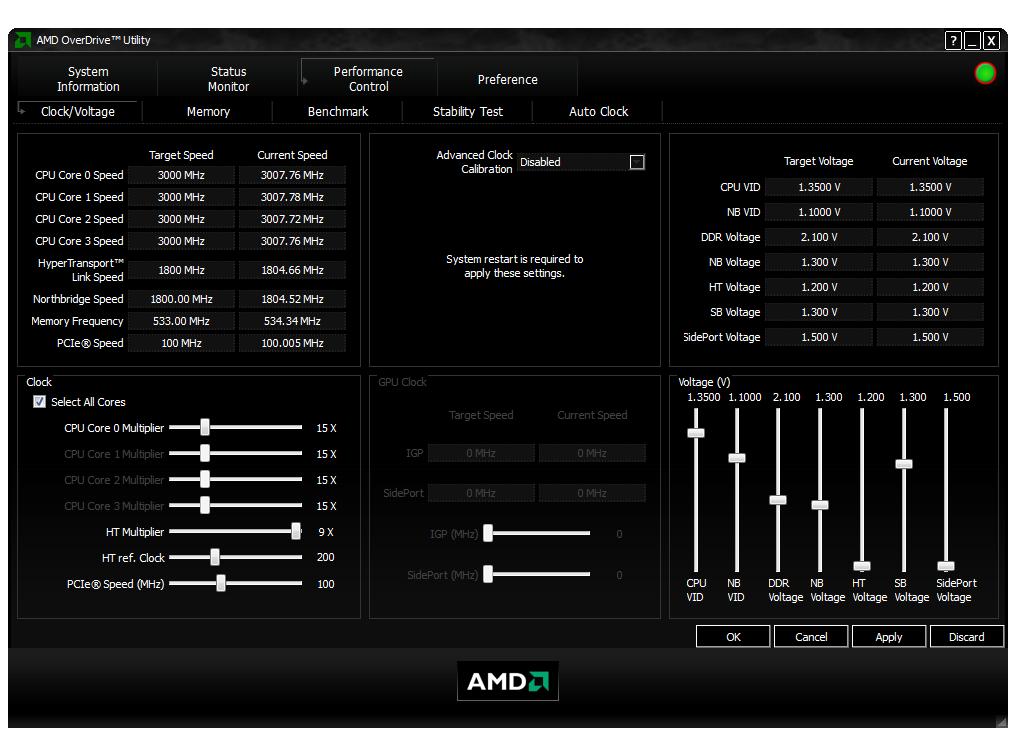
Expecting big gains from our Deneb chip, we skipped 15.5x and went straight to a 16x multiplier, resulting in a CPU core speed of 3,200 MHz. With a reference clock speed of 200 MHz, every full bump in multiplier will add 200 MHz to the core speed, while every half-multiplier increase will add 100 MHz. We stress tested our overclock with the AOD stability test and also Prime95’s small FFT test:

After passing 15 minutes of Prime 95 without an error, it’s time to make another bump in the multiplier. As in our example used earlier, a 16.5 multiplier results in 3,300 MHz. At this core speed our Phenom II breezes through the stability tests without a problem.
Stay On the Cutting Edge: Get the Tom's Hardware Newsletter
Get Tom's Hardware's best news and in-depth reviews, straight to your inbox.
A multiplier of 17 brings our core speed to 3,400 MHz and again the stability tests run without error:
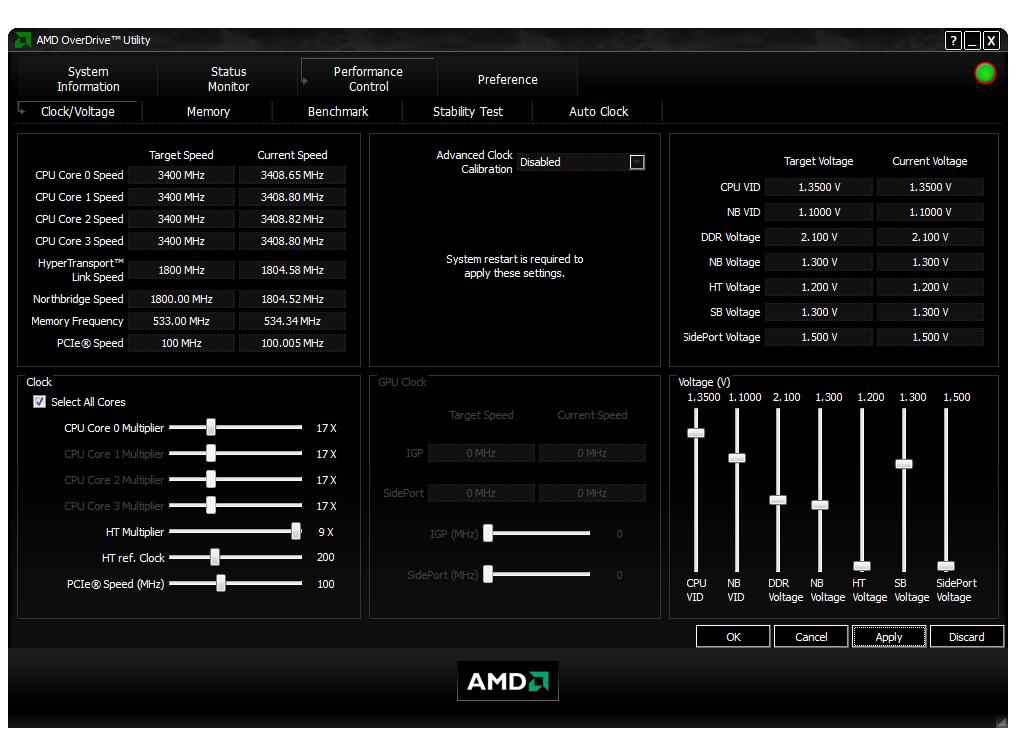
At 3.5 GHz, (17.5*200), we achieved stability throughout an entire one-hour test within AOD, but about 8 minutes into the even more stressful Prime95, we got the dreaded "blue screen" and the system then rebooted. We could pass any performance test we tried at these settings without fail, but ultimately, we wanted our system to pass a 30-60 minute Prime95 run. So our maximum overclock at stock 1.35 V CPU VID is somewhere between 3.4 GHz and 3.5 GHz. If you aren’t comfortable raising voltages, you can stop here. Or, proceed to find exactly the maximum stable speed at this voltage by bumping up the reference clock by one MHz at a time, which for us with a 17 multiplier would add 17 MHz at each increment.
If you are going to raise voltages, do so in small increments of 0.025-0.05 V at a time and keep an eye on temperatures as you go. Our core temperatures were low, and as we proceeded to slowly raise the CPU VID, we found that a small bump to 1.375 V was all it took for Prime95 stability at 3.5 GHz.
Stability with a multiplier set to 18 resulting in 3.6 GHz required 1.400 V. Pressing on in an attempt to reach complete stability at 3.7 GHz, we needed 1.4875 V, which is more voltage than AOD allows by default. Not everyone has sufficient cooling for this voltage, so raising this default limit requires editing AOD’s preferences .xml file with Notepad to allow the limit to be raised to 1.55 V.
It took 1.500 V CPU VID for stability in AOD at 3.8 GHz and an 18 multiplier, but even pushing all the way to 1.55 V did not enable Prime95 stability. Load core temperatures during Prime95 hovered around 55 degrees Celsius, and we then determined that we likely would need to bring this temperature down with better cooling.
Dropping back down to the 3.7 GHz overclock, Prime95 ran for a full hour in order to make sure the processor was stable at these settings. We proceeded to bump up the reference clock up one step at a time, stability testing each time a change was made. The maximum easy overclock achieved was 3,765 MHz (203*18.5).
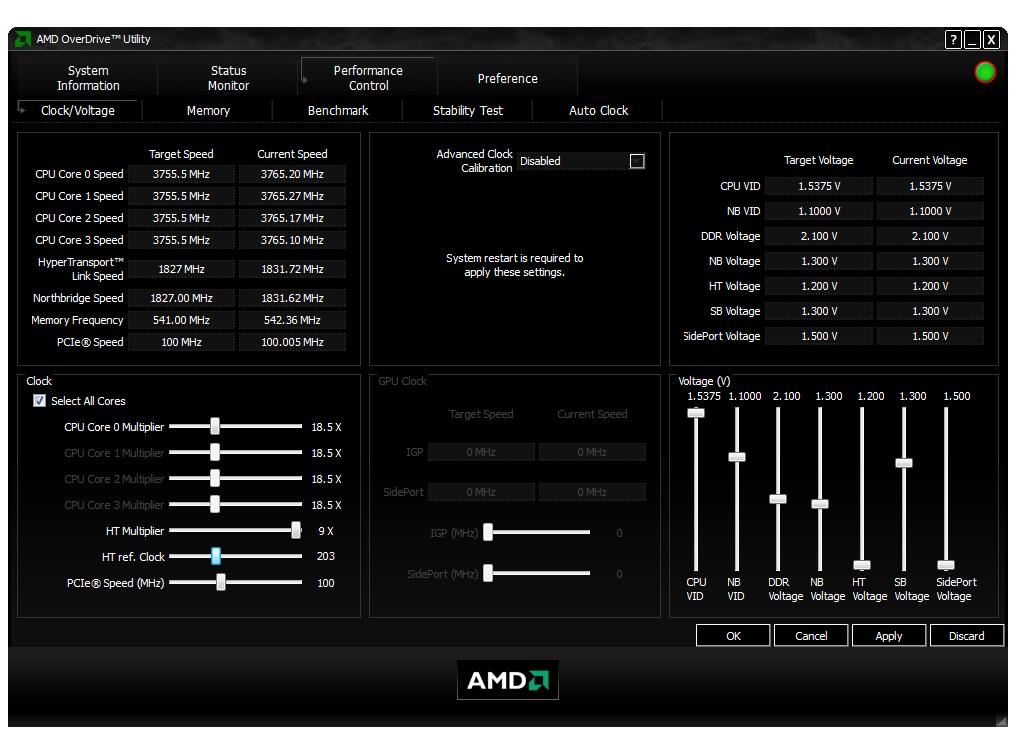
It is important to keep in mind that the speeds attained through overclocking and the voltages required to achieve them will vary from chip to chip, so as is always the case with overclocking, your mileage may vary. It’s also crucial to make voltage and frequency increases in small increments, to perform stability tests, and to keep an eye on temperatures as you go along. With these processors, more voltage is not always the answer, and they may actually lose stability as voltages are raised. Sometimes what is needed to push a higher overclock is simply better cooling. For best results, I’d recommend aiming to keep the load CPU core temperatures under 50 degrees Celsius.
While we may not be able to raise our core speed much higher, there is still more work to be done to maximize the performance of this system. Raising the northbridge speed, for example, can have a sizable impact on performance in some applications as it raises the memory controller performance and the L3 cache speed. The northbridge multiplier cannot be changed from within AOD, but instead must be done in the BIOS.
The only way to boost the northbridge speed from within AOD without rebooting would be to experiment with raising the core speed with a lower multiplier and higher reference clock. However, this will, in turn, also raise the HyperTransport link speed and the memory frequency as well. More on this subject will follow later in the guide, but first we will take a look at our other three Black Edition processors.
Current page: Easy Multiplier Overclocking
Prev Page An Intro To AMD OverDrive Next Page Easy Multiplier Overclocking (Cont.)-
xx12amanxx It's nice to see articles about AMD cpu's once again! Just goes to show that Tom's is not biased but rather report's on current trend's and competetive product's that the consumer's enjoy!Reply
-
Thanks for rev!Reply
Things i like to add are that not all CPU's are supported with AOD even having decent mobo, for example my 4850e + 780G. When overclocking NorthBrige you should really pay attention on it's temp, by simply touching it. Recently i overclocked my system by rising FSB and IGP. Looking at temps given by BIOS and some utilities everything seemed to be ok about 50c, but when touching pasivly cooled NB i couldn't hold my finger for second and heat was so great that even CPU got warmer! When i measured it with multimeter it was 85c idle! And i was wondering why on 3DMark i got blue screen... Problem was solved by adding fan in zone of NB.
Anyway, moral for those who are willing to overclock is - don't relay on temp measurements given by some utilities. Sometimes it's worth double checking or u can burn something easy. :) Good luck! -
jhanschu I realize that the price difference between the "black edition" and normal processors aren't that much, but I have been wondering how well the "vanilla" cpu's would oc. I've done some light searching for anyplace that's done this and haven't found anything other than people attempting to max out the BE's.Reply
Does anyone know what a good OC on say the X3 710 would be? It's about $40 cheaper than the 720BE and if it could even hit close to 3.0 I would consider it a decent buy. -
DjEaZy ... nice one... and for tha fun of it... would be nice to see a 'system build marathon' based on AMD CPU's...Reply -
roofus xx12amanxxIt's nice to see articles about AMD cpu's once again! Just goes to show that Tom's is not biased but rather report's on current trend's and competetive product's that the consumer's enjoy!Reply
I do agree. I honestly don't think TH ever conducted a boycott of AMD. They just needed something worth saying and AMD finally gave them that. Until Phenom 2, they really had not earned recognition for a good year and a half. They didn't have bad products, but very forgettable ones. -
iamlouie It seems like this article was written specifically for me. I recently built a new PC and it has components used in this article and I've also never overclocked a PC before.Reply
Specs:
ASUS M3A78-T
AMD Athlon 64 X2 7750 Kuma 2.7GHz
Patriot Extreme Performance SDRAM DDR2 800 (PC2 6400)
GeForce 7600GT 256MB
XIGMATEK HDT-S1283
Antec 500w Earthwatts power supply
My video card suits my current needs but if I upgrade to a 4870/4850, will I have any power issues if I follow this guide word for word considering my power supply is only 500w compared to the 650w the article uses?
-
iamlouieIt seems like this article was written specifically for me. I recently built a new PC and it has components used in this article and I've also never overclocked a PC before.Specs:ASUS M3A78-TAMD Athlon 64 X2 7750 Kuma 2.7GHzPatriot Extreme Performance SDRAM DDR2 800 (PC2 6400)GeForce 7600GT 256MBXIGMATEK HDT-S1283 Antec 500w Earthwatts power supplyMy video card suits my current needs but if I upgrade to a 4870/4850, will I have any power issues if I follow this guide word for word considering my power supply is only 500w compared to the 650w the article uses?Reply
A single 4850 and a dual core cpu around 3Ghz will be fine on your 500W PSU. If you had a cheap brand 500W PSU, I wouldn't risk it, but a 4850 should be fine for you.
The 4870 probably would be fine too but you would want to look into that before purchasing/installing the card.